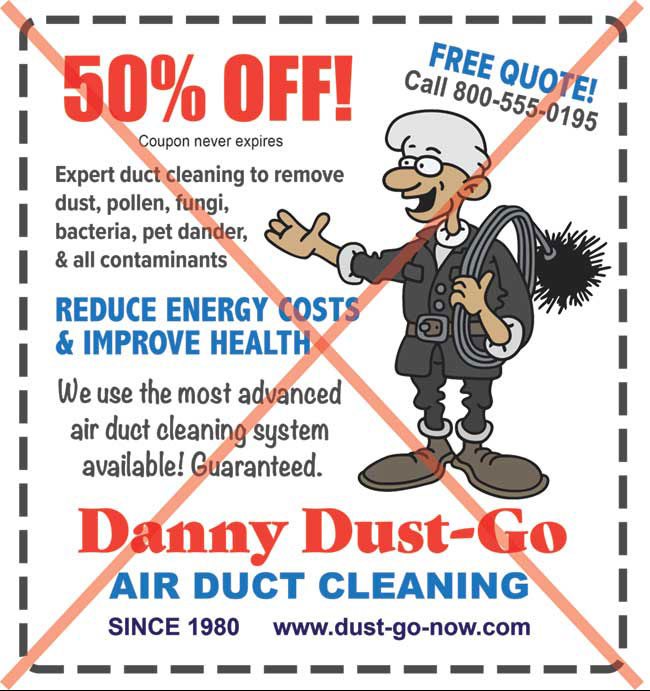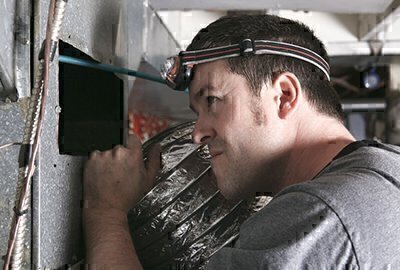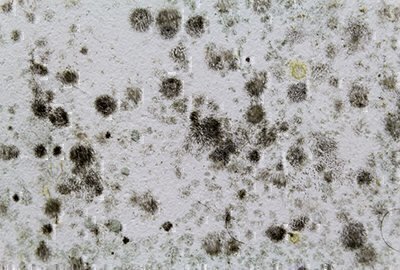Last updated November 2022
Don’t Hire Duct Cleaning Companies
Ignore deceptive ads and claims; you likely don’t need their services.
For many years, we’ve warned that HVAC system duct cleaning is a big waste of money.
Can ducts get dirty? They do. But air-quality experts consistently agree that ductwork cleanings provide no measurable benefit, even if residents suffer from allergies or asthma.
Maintaining clean ducts probably seems like something you should do. It’s reasonable to assume that having clean ducts would mean that air flowing out of your vents should come out cleaner too, right?
Well, actually, no.
Even if your ducts are very dirty, cleaning them likely won’t lower dust levels throughout your home. Dust that settles in your ventilation system generally stays put, unlikely to become airborne unless disturbed. Under most circumstances, it is inert and harmless—and stirring it up with cleaning equipment can actually create bigger problems.
(Note: While HVAC ducts do not need regular cleaning, the exhaust hose for your dryer, which can become clogged with lint, does need regular inspection to avoid a fire hazard.)
What They Do
To clean ductwork, companies place the duct system under negative pressure—essentially connecting a very large, powerful vacuum cleaner to one or more openings in the ductwork and sucking out loose dust and other debris. Because a vacuum isn’t powerful enough to loosen and remove all particles, duct cleaners must agitate the dust inside the ducts using a rotary brush, compressed air nozzles, and a tool called a “skipper ball.” Duct-cleaning companies may also clean the heating and cooling equipment (heat exchangers, cooling coils, condensate drain pans, fan motors, fan blades, and fan housings), but cleaning this equipment isn’t always included as part of their basic cleaning service.
 Why You Don’t Need It
Why You Don’t Need It
The duct-cleaning industry promotes a solution in search of a problem. Although duct-cleaning operations may insist their services are essential for your health, the evidence doesn’t support their claims.
The fact is dust that settles in your ventilation system generally stays where it is. Unless disturbed, it remains inert and harmless.
Unfortunately, many duct cleaning companies continue to mislead their customers, often promising health benefits. In our view, these claims constitute deceptive advertising. Some ads even use language like, “Studies have shown...” But no data back up these claims.
Other companies, plus their trade association, suggest that duct cleaning will lower your power bills by improving your system’s efficiency. That’s also dubious.
Air-quality experts don’t recommend regular duct cleanings. The official advisory of the U.S. Environmental Protection Agency (EPA) concludes:
Duct cleaning has never been shown to actually prevent health problems. Neither do studies conclusively demonstrate that particle (e.g., dust) levels in homes increase because of dirty air ducts. This is because much of the dirt in air ducts adheres to duct surfaces and does not necessarily enter the living space... Moreover, there is no evidence that a light amount of household dust or other particulate matter in air ducts poses any risk to your health.
Little independent research has been done on duct cleaning’s effects. The Canada Mortgage and Housing Corporation (CMHC) conducted a study in the 1990s to investigate whether duct cleaning makes indoor air healthier or reduces energy costs by improving airflow. After testing 33 homes in Montreal before and after professional duct cleaning, the study found no significant improvement in air quality and that duct cleaning alone did not improve airflow or energy efficiency. In some cases, measured particle levels actually increased immediately after a cleaning. In other cases, particle levels decreased immediately after cleaning, but returned to previous levels within weeks.
Like the EPA, the CMHC concluded that duct cleaning is unnecessary:
Although duct cleaning done by a professional duct cleaner will remove dust and debris…[it] will not usually change the quality of the air you breathe, nor will it significantly affect airflows or heating costs.
The CMHC study called on several different duct-cleaning services. The companies were not made aware they were part of a study, and the researchers did not control for time spent or methods used.
While the duct-cleaning industry argues that CMHC’s study has flaws, no other independent research has challenged its findings. And although the equipment and methods used by these companies have changed since CMHC’s study was conducted, the air ducts in homes are the same.
No public health group focusing on air-quality issues—the American Lung Association, Asthma and Allergy Foundation of America, or World Asthma Foundation—recommend regular duct cleaning.
 Want to Control Dust? Here’s What Actually Works
Want to Control Dust? Here’s What Actually Works
Frequently changing air filters is the best way to keep dust, allergens, and other particles out of your home. With a newly installed system, or a system in a home you’ve just moved into, check your filter monthly to determine how quickly it gets dirty at different times of the year. Most should be replaced every two or three months.
To further reduce dust and other allergens throughout your home, the Asthma and Allergy Foundation of America recommends:
- Establish regular cleaning routines.
- Keep humidity levels below 50 percent.
- Keep windows closed during peak pollen times or during times of high outdoor pollution.
- Remove strong scents like candles and harsh cleaners.
- Consider replacing carpet with solid-surface flooring.
- Replace bedroom pillows every two years, and wash bedding in hot water weekly.
- Visit aafa.org for additional recommendations, including specific tasks for bedrooms, bathrooms, living areas, and kitchens.
Duct Cleaning Won’t Save Energy, Either
Another sketchy claim made by most duct-cleaning operations and their trade association is that dirty ducts and equipment overburden heating and cooling equipment, which wastes energy. Again, it may seem as if a cleaner system will run more smoothly and last longer—after all, that’s why we and HVAC equipment manufacturers and repair services recommend that you regularly change your filters. But the page “Benefits of HVAC Cleaning” on the National Air Duct Cleaners Association (NADCA) website stretches this benefit too far by stating: “According to the U.S. Department of Energy, 25 to 40 percent of the energy used for heating or cooling a home is wasted.” And also: “According to the U.S. Department of Energy, homeowners can cut their energy bill by as much as 20% to 30% by simply doing proper HVAC system maintenance, including air duct cleaning.”
These statements are misleading.
Although much of the energy used to power heating and cooling equipment is indeed wasted, that waste largely is due to inefficient equipment, lousy insulation, leaks around doors and windows, and unsealed ductwork. While there’s some benefit to cleaning and maintaining HVAC equipment, that benefit is relatively small, and very little energy waste is attributable to dirty ducts or equipment.
Researchers for the Canadian duct-cleaning study found that when duct cleaners also cleaned the blower fan blades, there was a small reduction in airborne particles. Cleaning the blower fan might also slightly improve your system’s energy efficiency. The NADCA’s own white paper on HVAC energy efficiency makes similar conclusions. Still, completing these tasks will have a small effect on energy usage—and it definitely won’t greatly impact the 25 to 40 percent of energy wasted by residential HVAC systems. The Department of Energy’s estimates of energy waste clearly indicate that the vast majority of it occurs due to inefficient equipment, leaky ductwork, and homes passively allowing conditioned air to escape. For NADCA to relate energy-loss estimates to cleaning ductwork and other HVAC equipment is, at best, disingenuous.
If you’re concerned about energy waste, our section on Saving Energy at Home identifies ways to actually do that. Key tasks include having your duct system inspected for leaks, since leaky ducts lower efficiency and introduce air-quality problems, and sealing up leaks around doors, windows, and other trouble spots.
One HVAC-related cleaning task that might provide significant benefits is to regularly clean cooling-system evaporator coils. They cause condensation, dehumidifying the air before it circulates through your home. Condensed moisture can cause dust and other particles to stick to and build up on the coils. Also, cleaning the collector pan (and the drain spout in the pan) beneath the coils ensures that dirt doesn’t build up and get drawn into the system. It also prevents water, which can cause mold problems, from accumulating on and beneath the coils.
But we don’t recommend hiring a duct cleaner to perform these tasks; too many don’t know what they’re doing. We have ratings of duct-cleaning outfits here at Checkbook.org, but consider hiring a top-notch heating and air-conditioning contractor to do this type of work—or pay them to do it during their next service visit.
 Cleaners Might Damage Your Ducts and Home
Cleaners Might Damage Your Ducts and Home
Another reason to avoid duct cleaners: Performed improperly, duct cleaning can do more harm than good.
If the vacuum pressure isn’t applied carefully, some of the dust that settled in the ducts will be loosened by the agitation and blown into the living space after the cleaning. (This explains the results of the Canadian study in which particle levels actually rose immediately after a cleaning.)
Running brushes or using compressed air also risks breaking seals in the duct system, which can be especially problematic in the return-air portion. Most forced-air systems are designed as closed loops, and leaks in the return-air circuit allow unfiltered air to be sucked from basements or attics, bringing with it dust and moisture.
Not every home contains sheet-metal ductwork. Flexible coil-style ducts—the kind that looks like a Slinky—are more vulnerable to being punctured.
Ductwork fabricated from fiberglass-insulated material—less expensive than metal ductwork—has become more common in new homes. These ducts have fiberglass insulation on their interior surfaces. The fiberglass surface is sealed, but if a duct-cleaning company is not careful, the cleaning can damage the insulation, loosening fibers that can become airborne.
And, of course, there are the usual types of problems that can occur when you deal with any contractor—evidenced by the negative customer reviews some companies receive here at Checkbook.org.
Problems That Warrant a Cleaning
In general, consider duct cleaning only in response to specific identifiable problems. The EPA suggests doing it only if there is visible evidence of:
- Substantial mold growth (but see below)
- Infestation of insects or rodents
- Substantial deposits of dust or debris (if registers were not sealed during a renovation project, for example)
But the EPA also notes that hiring a duct cleaner to resolve one of these problems isn’t a permanent solution: “If any of the conditions above exists, it usually suggests one or more underlying causes. Prior to any cleaning, retrofitting, or replacing of your ducts, the cause or causes must be corrected or else the problem will likely recur.”
If anyone in your household has specific health concerns, such as allergies or asthma, consult your physician first. It’s important to identify the problem, so your doctor can suggest alternative courses of action to duct cleaning. Start by identifying whether your ducts are part of the problem (they probably aren’t) and whether getting them cleaned will help (it probably won’t).
 If You Have Special Concerns About Mold
If You Have Special Concerns About Mold
If you suspect a mold problem—either because of visible growth or a musty smell consistently coming from supply vents—cleaning ducts won’t do much good if it doesn’t eliminate the mold. Mold always begins with a moisture problem, and the ducts themselves are unlikely to be the source. The most likely culprits are the cooling system’s evaporator coils, which your heating and air-conditioning contractor—and most duct-cleaning companies—can inspect and maintain. Leaky return ducts can also introduce moisture. Again, if you suspect a mold problem, consider having a service company inspect the duct system for leaks. If you suspect—but aren’t sure—that what you see is mold, you might be tempted to have it tested. But experts we consulted generally recommend against it, reasoning that:
- Mold is present in all homes; it becomes problematic only when there is a moisture problem.
- It’s generally not worth the cost to test for mold or to identify the different kinds of mold present. Better to track down and eliminate moisture problems—whether under a sink or part of a heating and cooling system.
Still Going to Hire One? What to Look For and Avoid
If you decide to have your ducts cleaned anyway, don’t hire a company that makes sweeping claims about health benefits or that it’s “EPA-certified” for duct cleaning. There’s no such certification.
You’ll find customer reviews of duct-cleaning outfits here at Checkbook.org. We also evaluate HVAC services, which are better bets if you want to have your equipment serviced and cleaned.
Shop for a good price. Checkbook’s undercover shoppers collected price quotes from a handful of local companies for a straightforward duct-cleaning job, including equipment cleaning, and found huge company-to-company price differences among bids based on identical specifications. Quotes for our sample home ranged from less than $300 to more than $750. With some companies, cleaning the equipment was part of the deal—they did it whether you wanted it or not. Other companies impose an extra charge for equipment cleaning.
Beware of companies that quote very low prices (“$99!”). Most use low “starting” prices as a bait-and-switch tactic.
If you’re worried about specific contaminants (mold, dust), ask companies to inspect the job beforehand. Ask them to show you any contamination that would justify having your ducts cleaned. Be very skeptical if a company issues dire warnings about mold, which is usually not found in ductwork. If they suspect mold, ask them to submit the sample to a lab for analysis.
Another mega red flag: companies that propose applying biocides—agents that kill microorganisms. The EPA cautions against these chemicals. While some are approved for duct cleaning, the chemicals themselves can be irritants. If you choose to have a biocide applied as part of a duct cleaning, ask the company to present evidence that the chemical has been approved for use in duct-cleaning applications; it should have the EPA data sheet for the chemical on hand. Note: Biocides and other chemicals should never be applied to fiberglass-lined ductwork.
Confirm that any cleaning will cover the entire system. A cleaning should include supply ductwork, return ductwork, supply plenum (chamber), return plenum, and all registers and grilles. You may agree, for a reduced price—to exclude the blower-fan assembly, heat exchangers, evaporator coils, and collector pans—if those are serviced under a maintenance plan with a heating and air-conditioning contractor. But these are the elements most relevant to system efficiency and should be explicitly listed by the duct-cleaning company, unless you have agreed to exclude them.
Before agreeing to any work, get written estimates after each inspection.
Have the company agree in writing that it will perform the following (which mostly follow EPA recommendations):
- Open or create access ports or doors to allow the entire system to be cleaned and inspected.
- Inspect the system before cleaning to make sure there are no asbestos-containing materials (e.g., insulation, register boots, etc.) in the heating and cooling system. (Asbestos-containing materials should be disturbed or removed only by specially trained and equipped contractors.)
- Follow NADCA guidelines in attaching some sort of vacuum device to the system during cleaning to remove loosened particles.
- Use vacuum equipment that exhausts particles outside of the home or, if the vacuum exhausts inside the home, use only vacuuming equipment with high-efficiency particulate air (HEPA) filters.
- Protect carpet and household furnishings during cleaning.
- Use well-controlled brushing of duct surfaces in conjunction with contact vacuum cleaning to dislodge dust and other particles.
- Use only soft-bristled brushes for fiberglass duct board and sheet metal ducts lined internally with fiberglass. (Although flex duct can also be cleaned using soft-bristled brushes, it can be more economical to replace accessible flex duct.)
- Take care to protect the ductwork, including sealing and reinsulating any access holes that have been made or used.
- Follow NADCA standards for air-duct cleaning and North American Insulation Manufacturers Association recommended practices for ducts containing fiberglass lining or constructed of fiberglass duct board.


